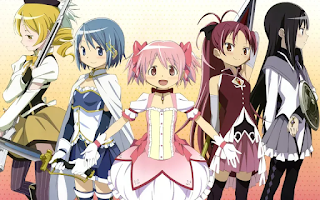
I'll admit it: the appeal of anime eluded me for a long time. Like a lot of Western viewers, I allowed my perception of the genre from stereotypes, cultural osmosis and half-remembered Pokémon episodes to prevent me from seeking it out. And to be sure, plenty of series live down to the stereotype: lots of yelling and berserk action, gross, often age-inappropriate fanservice, an animation style that takes getting used to. Fortunately, I've managed to shed my prejudices and enjoy a fair amount of anime, from the conventionally-appealing (Studio Ghibli) to the experimental (Revolutionary Girl Utena); from the light wackiness of K-On! to the existential grimness of Erased.
No series affected me as much as Puella Magi Madoka Magica, Studio SHAFT's remarkable series from 2011 (which I wrote about extensively here). A dark subversion of the Magical Girl genre popularized by Sailor Moon, it's an extraordinary blend of surreal animation, sharply-wrought characters and heart-wrenching moral dilemmas. In 2012, the anime was reedited into two feature films that provide a fair introduction to the show, even if they don't quite match its full-length brilliance.
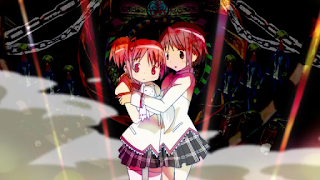
Puella Magi Madoka Magica follows Madoka Kaname, an ordinary adolescent who’s unwittingly swept into the world of Magical Girls – young women adorned with magical powers to fight reality-warping “Witches.” Madoka Magica recasts the Magical Girl’s transformation as a Faustian pact with Kyubey, an emotionless cat-like alien with ulterior motives for offering humans unlimited power. Madoka is restrained from making her pact by the mysterious transfer student Homura Akemi, though her impulsive friend Sayaka Miki (wishing to save the boy she loves from a devastating injury) takes the plunge with tragic results. The narrative also introduces Mami Tomoe, the magical mentor who shows Madoka and Sayaka how to get ahead, and bad girl Kyoko Sakura, constantly munching junk food and issuing cynical advice between battles. The series transforms from lighthearted adventures to heavy explorations of survivor’s guilt, the nature of selfishness (and selflessness), a person’s individual worth and the nature of hope in a bleak and despairing world.
Produced by Studio Shaft, Madoka Magica brought together a unique intersection of talent, dubbed the “Magica Quartet.” Ume Aoki, creator of the endearing shoujo manga Hidamari Sketch, was tasked with designing the characters. Writing duties went to Gen Urobuchi, the intense scenarist behind violent, philosophically dense stories like Fate/Zero and Psycho-Pass. Producer Atsuhiro Iwakami was a frequent collaborator with Urobuchi, while director Akiyuki Shinbou made a variety of works for Shaft, including the anime version of Hidamari Sketch and his own Magical Girl series, Magical Girl Lyrical Nanoha, which proved a direct forerunner for Madoka.
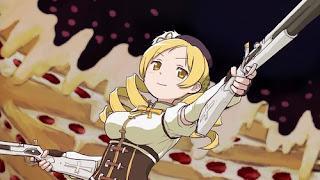
Purely on a visual level, Madoka is transcendent. Director Shinbou enlists Inu Curry, an artist's collective specializing in experimental animation, for some of the most incredible animation ever staged. The simple, even cutesy character designs clash immediately with the stark backgrounds, creating a post-industrial mindscape of schoolrooms, malls and shopping districts that are curiously unoccupied. There's a spatial eeriness to the Madokaverse that renders even the early, mundane scenes unsettling in a way. Which is underscored by Yuri Kaijura's spooky score, often stirring and transcendent, often eerie and mournful, with Eastern European style folk cues that tug at the heartstrings.
But the true highlights, visually, are the Witches' labyrinths. Each Witch inhabits their own pocket universe with surreal visuals reflecting their psyche, and villainous Familiars that do its bidding. Curry's work in these scenes is nothing short of mind-blowing: employing an incredible blend of collage animation styles - CGI, live action, hand-drawn and even puppetry - they craft high-tech Boschian dreamscapes, sometimes whimsical (Charlotte, the "Sweets Witch," with her roly-poly candy henchmen), often nightmarish (Oktavia, a giant mermaid-knight who conducts a demonic orchestra with her sword). Which isn't to say that the invention's limited to the labyrinths: the most spellbinding sequence features Kyoko explaining her tragic backstory, in a stylized shadow play worthy of Lotte Reiniger.
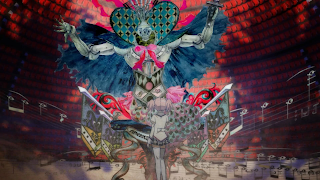
At first, Madoka unfolds like a standard Magical Girl show: Madoka is introduced to Kyubey, mentored by Mami and ponders becoming a Magical Girl herself. Then Mami is gruesomely devoured by Charlotte (a twist memetic enough that I don't mind spoiling it), leading to an immediate, irrevocable shift in tone. The more we learn about the Magical Girl system, the less appealing it seems: Kyubey's answers about contracting become evasive, while Homura murmurs dread warnings and the predatory Kyoko swoops in to claim Mami's territory. This doesn't stop Sayaka from contracting, and her descent into madness provides Madoka's emotional core.
What follows is a heartrending portrait of emotional damage. Each of the heroines are tricked or trapped by Kyubey into contracting, without a full realization of what being a Magical Girl entails or the cost they'll incur. Mami, having saved her own life during a car accident, is left alone, forced to play "cool senpai" to Madoka and Sayaka even as she suffers in private. Kyoko's wish to help her starving family leads ultimately to their deaths, and her becoming a homeless outcast. Sayaka's driven by her desire to heal her crush, musician Kyosuke, while her contrast with the selfish Kyoko initially provides motivation to be a selfless Magical Girl. But Sayaka realizes that her selfish motivations and selfless intent aren't easily separated...especially when Kyosuke falls for Hitomi, Sayaka's non-Magical friend. The resulting mental deterioration is painful to watch.
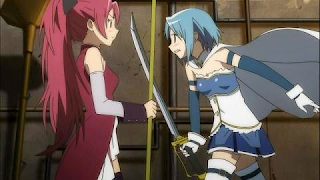
Ultimately, Homura's story takes center stage. At first she's merely an aloof girl, whose cryptic warnings and uncanny battle skills inspire distrust and fear from Madoka and Sayaka. But it soon becomes apparent that this guarded, hair-flipping badass is herself a deeply shattered soul. Her cards are finally laid on the table when it's revealed that she was originally a shy nebbish, unable to make a friend except Madoka - and whose wish sent her back in time to save Madoka. This dooms her to a Groundhog Day-loop of watching her friends die, over and over again, with the expected accumulation of trauma as she can't figure out how to thwart Kyubey, or the climactic witch Walpurgisnacht.
What elevates Madoka Magica above "misery porn" is how deeply it empathizes with its heroines. Urobuchi paints each of the Puella Magi as a victim of trauma and manipulation, with Kyubey's machinations playing out like emotional abuse (especially when he blames them for not asking the right questions about the Magical Girl system). His later claims of acting for a Greater Good ring hollow when it's clear how dishonest and heartless he is; some viewers, inexplicably, view him as embodying Urobuchi's mindset about the fragility of girls, thus painting Madoka as a misogynist tract. This argument would be more persuasive if the words didn't come from the mouth of Urobuchi's villain, and weren't violently contradicted by his heroine.
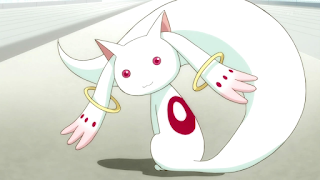
Ultimately, Urobuchi offers his heroines a way out of the Labyrinth. Each forms human connections they were missing: Kyoko and Sayaka, after an initially-violent rivalry, form an affection bordering on romance that allows both to (briefly) experience the transcendence of friendship. If Homura's actions are often cold and manipulative, her devotion to Madoka is absolutely sincere, and her refusal to give up ultimately provides Madoka motivation to transcend her own doubts. No longer viewing herself as an ordinary girl with no worth to anyone, she allows her sense of hope and love to overcome Kyubey's rotten system.
Fans of the anime will definitely notice, and likely criticize the movies' alterations. Beginnings, the first film, suffers from its heavy editing: it compresses the first eight, half-hour episodes of the show into 131 minutes, leading to severe cuts. The biggest differences involve cuts to supporting characters, especially Sayaka (who goes from the central character for the middle third of the anime to a secondary character) and Mami (who loses a key scene explaining her backstory). Nothing fatal, but rearranging scenes Jenga-like to create a streamlined cinematic narrative does undercut Urobuchi's tight-to-a-fault screenplay. First time viewers are encouraged to try the series before checking out the films.

Even so, Puella Magi Madoka Magica is a dense, thoughtful and emotionally-wrought experiment in whatever form you experience it. It’s not merely a clever deconstruction, nor is it “misery porn” even if Urobuchi sometimes enjoys framing it that way. It’s a tragic, but ultimately uplifting story of young women trapped by, fighting and overcoming a soul-destroying world. Miracles and magic are real, but they come with a price. Hope has its place, but should be tempered with reality. Selfishness and sacrifice aren’t always easily distinguished. Connections are worth pursuing, even if they’re fleeting. And for all the darkness inherent in the world, there is enough to live for that you shouldn’t ever give up.

